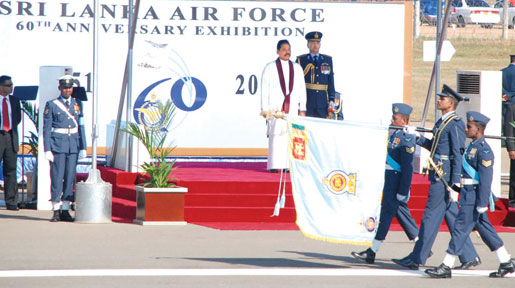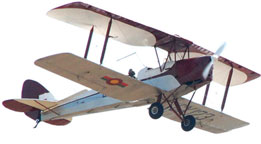|
SLAF celebrates 60 years:
Resolute, innovative air power
By Dhaneshi YATAWARA
Withstanding many challenges the Sri Lanka Air Force today celebrates
60 years of its remarkable journey to achieve excellence. During this
six long decades the Sri Lanka Air Force (SLAF) has been in the
forefront in ‘Protecting the Lankan Skies’ (‘Surakimu Lakambara’). The
past four years could have been the most challenging period in which the
Air Force displayed the best of their abilities.
 |
|
The Air Force honouring
the Commander-in-Chief President Mahinda Rajapaksa |
The SLAF underwent a dramatic change as an Armed Force during Eelam
war IV under the unwavering leadership of President Mahinda Rajapaksa
and the clear guidance of Secretary Defence Gotabaya Rajapaksa. The Air
Force grew into an exemplary fighting unit during the past few years.
Rather than following traditional Armed Force duties, the SLAF has
taken a step ahead to address national issues, be it development
activities or a disaster situation. Today they are capable of coping
with any threat. They are geared to performing their duties in a far
more advanced level of professionalism, efficiency and commitment
becoming a resolute and innovative air arm in the region. They have
turned out to be a multi-faceted wing which shoulders a major portion of
the country’s development and disaster management in addition to
adhering to their prime task of safeguarding the territorial integrity
and sovereignty of the country. At what other time other than the
Diamond Jubilee they could showcase their ultimate achievement and
skills.
Royal touch
It was established on March 2, 1951, then known as the Royal Ceylon
Air Force a.k.a. RCyAF, under the command of Air Commodore G.C. Bladon,
the headquarters were at Parsons Road, Colombo which was then known as
Riffle Green House. Chipmunks were the first aircrafts that were
inducted to the RCyAF and step, by step the fleet expanded with the
subsequent addition of Balliol and De Havilland Dove air craft and
Dragonfly helicopters. In 1959, during the command of Air Vice Marshal
J.L. Barker the Jet Provost aircraft joined the fleet and that was the
Air Force’s first encounter with jets.
The first regimental squadron was formed in 1960. Air Vice Marshal
E.R. Amarasekara was appointed as the next Air Force Commander in 1962,
thus becoming the first Sri Lankan Air Force Commander. By 1966, Air
Vice Marshal Amarasekara managed to fill the Air Force cadre with
Ceylonese nationals. Then in 1971 they had the youngest Commander of the
Air Force - Air Chief Marshal P.H. Mendis who was 38-years-old. During
his tenure the RCyAF became the Sri Lanka Air Force when the country
became a Republic under the United Front Government.
 |
|
Defence Secretary Gotabaya Rajapaksa,
Chief of Defence Staff,
Air Chief Marshal Roshan Goonetilake and Air Force Commander
Air Marshal Harsha Abeywickrama in conversation. |
The first major operational call for the Air Force came in with the
1971 insurgency. In 1972, Sri Lanka Air Force was awarded with the
prestigious President’s Colours recognizing the service rendered to the
country.
Radical changes
Air Chief Marshal Harry Goonetileke became the fifth Commander of the
Sri Lanka Air Force in November 1976. He successfully expanded Air Force
operations to the four corners of the country. He is the key figure to
contribute greatly to develop SLAF sports. During the tenure of the
sixth Commander of the Air Force, Air Chief Marshal D.C. Perera the
aircraft fleet expanded immensely with the induction of nearly 20
aircraft. Among them were the Bell 212 and 412 helicopters, Siai
Marchetti SF260s, Cessna 337s, Avro HS748s and Beech King Aircraft.
Seeing the signs of the Northern insurgency the SLAF continued to
establish more airfields and runways across the country.
During Air Chief Marshal A.W. Fernando’s command from 1985, SF 260TP
light ground attack air craft, Y-12 and Y-8 light air crafts were
inducted to the inventory. This was mainly to strengthen the support
extended by the Air Force to the Northern and Eastern military
operations that were growing intensely.
It was during the tenure of Air Chief Marshal M.J.T. de S.
Gunawardena’s period (SLAF’s eighth Commander) the Chinese F-7s were
inducted to the Air Force and they were the first supersonic jet
interceptors for the SLAF. The IA 58 Pucara Ground Attack Aircraft and
three Russian MI -17s were also acquired. Air Chief Marshal Gunawardena
made a radical change in the SLAF management structure by introducing
the Zonal Command concept to intensify operational requirements. It was
in 1996, during Air Chief Marshal Oliver Ranasinghe’s tenure (the ninth
Air Force Commander) the Israeli built Kfir Aircraft and the Russian
MI-24s were inducted to the Air Force. The AN 32B transport aircraft and
more MI-17 helicopters were also added to the fleet during this time.
 |
|
Siai Machetti |
This advancement began to provide tremendous service in tactical
transportation to the Northern and Eastern Operations. It was during
this period, Unmanned Ariel Vehicle technology was introduced to the Air
Force. This was a force multiplier to the ground forces. It was during
this period that Air Force achieved the National Quality Awards for the
excellence in large scale service category. In 1998, Air Chief Marshal
J. Weerakkody took over as the tenth Commander of the Air Force.
The MiG 27 flogger aircraft was added to the SLAF inventory during
his tenure and the transport capabilities were advanced with the
addition of C130 Hercules aircraft. Air Chief Marshal Weerakkody was
instrumental in establishing the Junior Command and Staff College in
China Bay.
To mark the 50th Anniversary of the Air Force in 2001 the oldest base
and the oldest formation of the SLAF, the Katunayake base and No.1
flying training wing were honoured with President’s Colours. Under the
command of Air Chief Marshal Donald Perera (eleventh commander) the SLAF
air defence capabilities were enhanced to face the air capabilities of
the enemy which was seen developed during that time period. The ground
based Air Defence Radar System, Anti Aircraft Artillery as well as
shoulder fired Surface-to-Air Missiles were included into the inventory.
During this time the SLAF bagged the National Productivity Award - 2003
in the Government Department Category.
After the 2004 tsunami the SLAF carried out a heavy load of rescue
missions and carried relief items to the victims amidst the heavy battle
against terrorists. In June, 2006 Air Chief Marshal Roshan Goonetileke
took over the commandership of the SLAF.
The political leadership under President Mahinda Rajapaksa was
determined to wipe out terrorism from the country permanently and the
SLAF geared up to make the victory a reality. Under Air Chief Marshal
Goonetileke’s command the SLAF upgraded itself with modern technological
equipment steering the SLAF to a new dimension which enabled to
accomplish the tasks assigned.
 |
|
Vintage aircraft still
in function - Tiger Moth |
 |
The F7 GS fighter jets were inducted to the SLAF which were the most
sophisticated fleet in terms of avionics. During the past few years the
SLAF aquired new ariel reconnaissance capabilities by adding new
Unmanned Ariel Vehicles and many other state-of-the-art technology for
accurate intelligence gathering which lead to accurate targeting both by
air and ground troops.
The SLAF was awarded with President’s Colours in 2009 and also bagged
the National Productivity Award.
The new Commander, Air Marshal Harsha Abeywickrama, following his
tedious work as the Director Air Operations during the height of the
operations and as a well experienced Deputy Chief of Staff takes over
the Air Force 13th Commander’s post at the transition period of the SLAF
from military operations to peace time operations.
Air Marshal Abeywickrama, during his tenure as the Director Air
Operations was instrumental in the revolutionary development of combat
capability of the Sri Lanka Air Force and was the driving force behind
the many successful air operations during the humanitarian operation.
The SLAF celebrated its Golden Jubilee on March 2, with the largest
ever march past held in SLAF history which comprised over 1200 Air Force
personnel. This included 98 officers and four Warrant Officers.
A large number of top ranked officers of Air Forces from India,
Pakistan, China as well as diplomats who graced the occasion to honour
the Sri Lanka Air Force.
Today the SLAF exhibits its grandeur and valour symbolizing its
commitment and strength to protect and develop this island nation into a
more precious state.
|

